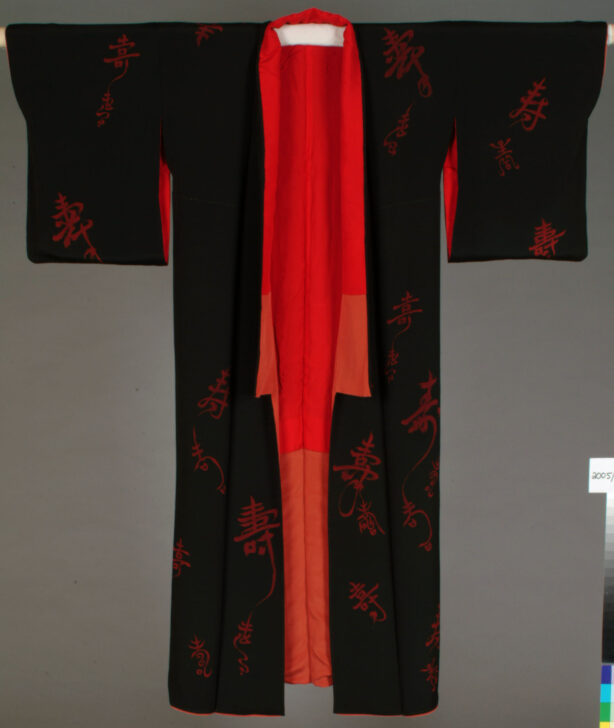Black kimono with the character kotobuki in several scripts, in deep red
Japanese

Description
Copies and Invention in East Asia (August 17, 2019 - January 5, 2020)
The black Japanese kimono displayed nearby is decorated with the same character. This type of kimono is worn to celebrate a sixtieth birthday, an important benchmark in life.
Gallery Rotation Fall 2013
Kimono
Japan, Showa period (1926–1989)
1940s–50s
Black silk crepe with red paint
Gift of Howard and Patricia Yamaguchi, 2005/1.390
This striking black kimono with red characters was created using a hand-painted dyeing technique called yûzen. This technique was developed in Kyoto around the turn of the eighteenth century to meet the demand for colorful, detailed kimono from the wealthy samurai and merchant classes. To create its characteristically vibrant pictorial designs, yûzen makes use of paste-resist and a variety of dye colors applied in successive layers.
This kimono could have been worn at kanreki, a sixtieth-birthday celebration. The character kotobuki, painted in various styles in red using the yûzen technique, means happiness, celebration, or longevity. The lining is also red, which contrasts starkly with the black outer fabric. The color red is believed to dispel malaise and sickness; here it expresses the wish that the person celebrating her sixtieth birthday would continue to enjoy a long, healthy life.
Subject Matter:
Kotobuki is the chinese character carrying meanings of longevity and congratulations. This kimono may be a pair with 2005/1.352, a haori with blue kotobuki characters.
Physical Description:
Silk crepe dyed black with areas of wax-resist in the shape of kotobuki characters. These characters were brushed with red, which matches the inner red lining of momi plain weave silk above with persimmon silk crepe below.
Usage Rights:
If you are interested in using an image for a publication, please visit https://umma.umich.edu/request-image/ for more information and to fill out the online Image Rights and Reproductions Request Form.